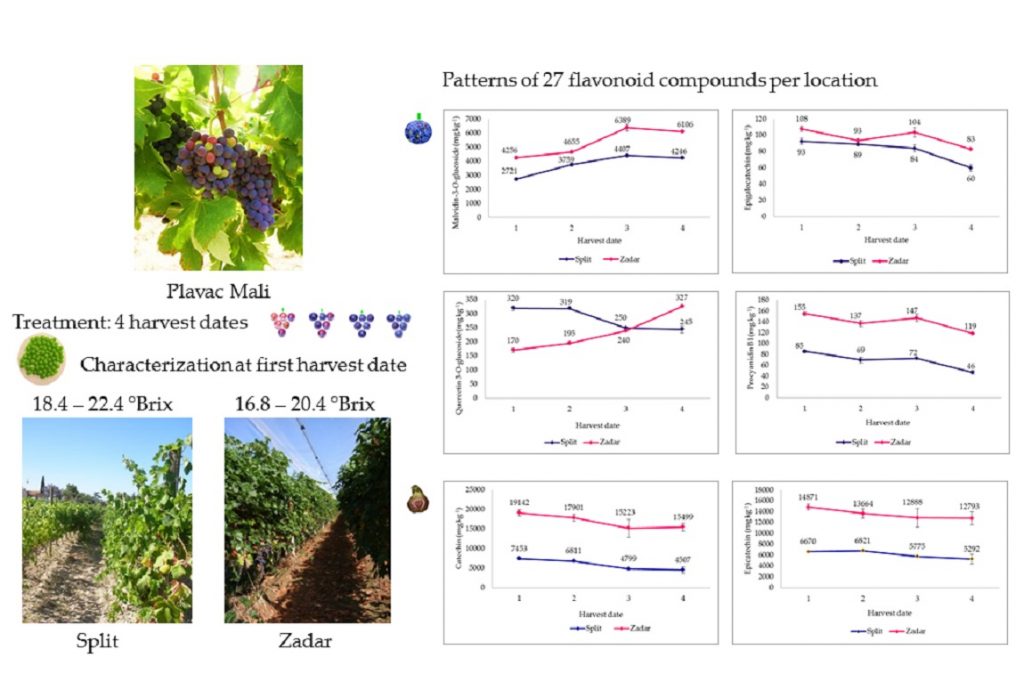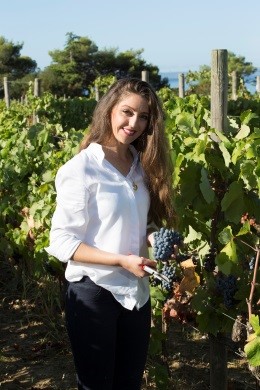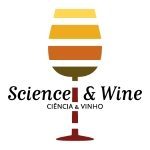Ana Mucalo, Edi Maletić and Goran Zdunić

Each year, appropriate harvest dates receiving great attention due to their irreplaceable role in natural modulation of the wine style in the vineyard and reduction of production costs in winery. The enological potential of the berries depends on the quantitative and qualitative polyphenolic profile of the berries in the time of harvest 1,2 and their extraction during vinification 3,4,5. Harvest before berries reached technological maturity, known as cessation of active sugar accumulation, is associated with fresh wines, low in alcohol, high in acids, with a light and vivid color, thin body, bitter taste and astringent sensations 1,2. Peak in aromatic and flavor complexity, fruity scents and full body, soft tannins wines are associated to phenolic maturity of the grapes 4,6,7. Extended hang time is controversial issue as in certain vintages gives extraordinary quality 2,3,8 however, compromised wine quality potential is reduction of natural acidity, increase in pH, reduction of anthocyanins, shift in color toward violet, reduction in polyphenols and color 6,9 and a prevalence of cooked, jammy and waxy types of aromas and flavors of raisins 1.

Wines produced from grapes that did not reach phenolic ripeness are less colored (Figure 1) and more bitter and astringent, due to reduced anthocyanin and skin proanthocyanidin and greater seed proanthocyanidin extractability 2, which negatively influences the sensory profile of wine 10. Harvest beyond phenolic ripeness to achieve better coloration and velvety tannins often results in unbalanced wines high in alcohol, low acid content, and high pH, with a higher proportion of seed proanthocyanidin extraction linked to wine matrix composition 5,6. Such wines are also associated with sluggish fermentation or problematic malolactic fermentation and reduced wine aromatic potential without must N-supplementation 1. The production of well-structured, balanced wines from the Plavac Mali grape is becoming very challenging in the warm Mediterranean coastal region of Croatia due to climate change. Plavac Mali is a late-ripening red variety used to produce premium red wines on the islands and coastal region of central and south Dalmatia in Croatia. It is characterized by low sensitivity to bunch rot, firm skin and high concentrations of anthocyanins. The seeds and skins of Plavac Mali are rich in flavan-3-ols, catechin, epicatechin and dimers, moreover recently a high impact of berry proanthocyanidins on the sensory perception of astringency and bitterness in Plavac Mali wines was reported 11. It is not surprising, therefore that mouthfeel sensory attributes of Plavac Mali wines are often described as too harsh or very astringent. Generally, there is decline in seed and skin proanthocyanidins during ripening that complicate finding the appropriate harvest moment for Plavac Mali. A certain degree of heterogeneity in the ripeness of berries in Plavac Mali at the time of harvest has been reported 12 and immature (green) berries as an unexploited source of phenols can seriously impair the quality of the wine. Although some qualitative responses are known for varieties of a wide range of cultivation further remain unknown for local varieties in their specific terroirs. Given the gaps in knowledge, this study delivers a comprehensive flavonoid fingerprint profile, physiochemical and external color characterization of Plavac Mali grapes through four harvest dates at two distinct vineyards (Split and Zadar) in the Eastern Adriatic region. The experimental harvest lasted 56 days, at total soluble solids content from 18.4 to 22.4 °Brix in Split and 16.8 to 20.4 °Brix in Zadar. Patterns of 27 skin and seed flavonoid compounds at each location indicate unique flavonoid composition of berries at each harvest date. Immature berries were separated from first harvest date, and analyzed to determine sugar, acid concentration, pH, potassium, and flavonoid composition.

Extended harvest increased six compounds in skin with maximum values of main anthocyanin malvidin-3-O-glucoside in H3 (4406.6 and 6389.5 mg kg −1, Split and Zadar, respectively) followed by a decrease in October (Figure 2). Peak values of seed and skin catechins and galloylated flavan-3-ol subunits are seen in early harvest dates at Split, while constantly high values are reported in the case of Zadar, with an incoherent pattern of those in skin extracts. Minimal values of epigallocatechin were detected with an extended harvest date at both locations. Berries of extended harvest dates underwent colorimetric improvements, trough decrease in L*, a*, b* and C characteristics and increase in skin color index for red grapes CIRG.
This study shows large differences in qualitative and quantitative flavonoid composition of Plavac Mali grapes as an effect of extended harvest date at two different agro-ecological locations. The extended harvest date increases the total soluble solids, pH, and changes the flavonoid composition in favor of anthocyanins and flavonols. Total acidity and flavan-3-ol monomer and dimer compounds related to a grape skin and seed extracts decreased with the extension of harvest date. Changes in chromatic characteristics occurred simultaneously with developmental changes in anthocyanin profile, but from a practical point of view those parameters can be easily used as indicators just for a rough selection between unripe and grapes that reached phenolic ripeness; afterwards, changes in CIRG value fade away. Moreover, for a practical implication of this index, a “sense of place” of vineyard should be taken in consideration. Immature berries separated from bunches of first harvest date had a lower sugar and pH, and higher acidity content, however in their flavonoid composition seed flavan-3-ol monomers and dimers predominate. Much of the conventional and flavonoid composition patterns differed between the two locations and could be associated with multiple differences in environmental conditions that may have affected the berries in the two locations, also corresponding interaction with harvest date suggest a need of adjustment of optimum ripeness indicators under the environmental conditions of each individual location. Finding the optimum moment for grape harvest is a technological challenge, as conventional indicators of ripeness (sugar, total acidity and pH) and the polyphenolic indicators (anthocyanins, flavonols and monomer and dimer proanthocyanidin units) split up significantly, with different optimal harvest dates. Conventional indicators were optimal at second and flavonoid indicators at third harvest date.
See all at: Mucalo, A.; Maletić, E.; Zdunić, G. Extended Harvest Date Alter Flavonoid Composition and Chromatic Characteristics of Plavac Mali (Vitis vinifera L.) Grape Berries. Foods 2020, 9, 1155. https://doi.org/10.3390/foods9091155

Ana Mucalo 
Edi Maletić 
Goran Zdunić
Dr. Ana Mucalo, PhD in viticulture and enology . Research associate currently working at the Department of Plant Sciences, Institute for Adriatic Crops and Karst Reclamation in Split (http://amucalo.os.krs.hr/en/). Ana’s research project is focused on the eco-physiology of grape ripening and biochemical changes in berries during ripening in the coastal climates of Adriatic sea and, consequently, the impact of harvest and location driven changes in metabolic profiles on wine quality. She has participated in 10 international/national research projects in the field of viticulture and oenology. She is author/co-author of 13 research articles in peer reviewed journals, and has attended as a speaker at various international and national scientific conferences.
Prof. Edi Maletić, PhD. Tenured Professor of Introduction to grape and wine production (Bs), Ampelography, Grapevine nursery production (Ms), Ampelography research methods (PhD) at the University of Zagreb, Faculty of Agriculture (http://www.agr.unizg.hr/en/category/about_us/1). Edi’s main area of research is focused on ampelography, grapevine genetic resource, clonal selection and grapevine plant material production. He was principal investigator in several national and international scientific projects, and also in many applied research projects related to native grapevine varieties identification, evaluation and revitalization. He is author/co-author of more than 200 scientific papers in international scientific journals and proceedings of international conferences and 9 author books. He is Croatian delegate and Vice-President of the “Genetic Resources and Vine Selection” Expert Group at OIV (International Organization of Vine and Wine), Paris. Internationally, Edi is known as one of researchers who participated in Tribidrag/Zinfandel/Primitivo origin.
Dr. Goran Zdunić, PhD. Scientific Adviser at the Department of Plant Sciences, Institute for Adriatic Crops and Karst Reclamation in Split. Goran’s research is focused on study of genetic variability of varieties using morphological and genetic methods. He is coordinator of several research projects on identification of grape varieties and natural wild grape populations (Vitis vinifera L.subsp. sylvestris), more recently focused on the analysis of drought tolerance genes, and the identification of drought tolerant genotypes and grape varieties. He is author/co-author of more than 100 scientific papers in international scientific journals and proceedings of international conferences. He was awarded the Fulbright scholarship for the 2011-2012 to conduct research at the National Clonal Germplasm Repository, UC Davis, United States of America.
References:
- Bindon, K.; Varela, C.; Kennedy, J.; Holt, H.; Herderich, M. Relationships between harvest time and wine composition in Vitis vinifera L. cv. Cabernet Sauvignon 1. Grape and wine chemistry. Food Chem. 2013, 138, 1696–1705. [CrossRef]
- Kontoudakis, N.; Esteruelas, M.; Fort, F.; Canals, J.M.; De Freitas, V.; Zamora, F. Influence of the heterogeneity of grape phenolic maturity on wine composition and quality. Food Chem. 2011, 124, 767–774. [CrossRef]
- Bindon, K.A.; Madani, S.H.; Pendleton, P.; Smith, P.A.; Kennedy, J.A. Factors affecting skin tannin extractability in ripening grapes. J. Agric. Food Chem. 2014, 62, 1130–1141. [CrossRef]
- Garrido-Bañuelos, G.; Buica, A.; Schückel, J.; Zietsman, A.J.J.; Willats, W.G.T.; Moore, J.P.; Du Toit, W.J. Investigating the relationship between grape cell wall polysaccharide composition and the extractability of phenolic compounds into Shiraz wines. Part I: Vintage and ripeness effects. Food Chem. 2019, 278, 36–46. [CrossRef] [PubMed]
- Rousserie, P.; Lacampagne, S.; Vanbrabant, S.; Rabot, A.; Geny-Denis, L. Influence of berry ripeness on seed tannins extraction in wine. Food Chem. 2020, 315, 126307. [CrossRef]
- Schelezki, O.J.; Smith, P.A.; Hranilovic, A.; Bindon, K.A.; Jeffery, D.W. Comparison of consecutive harvests versus blending treatments to produce lower alcohol wines from Cabernet Sauvignon grapes: Impact on polysaccharide and tannin content and composition. Food Chem. 2018, 244, 50–59. [CrossRef] [PubMed]
- Allegro, G.; Pastore, C.; Valentini, G.; Muzzi, E.; Filippetti, I. Influence of berry ripeness on accumulation, composition and extractability of skin and seed flavonoids in cv. Sangiovese (Vitis vinifera L.). J. Sci. Food Agric. 2016, 96, 4553–4559. [CrossRef]
- Black, J.A.K.; di Profio, F.; Le Dauphin, V.; Moreno, L.H.; Reynolds, A.G. Impact of crop level and harvest date on anthocyanins and phenolics of red wines from Ontario. Can. J. Plant Sci. 2016, 96, 1045–1059. [CrossRef]
- Moreno Luna, H.L.; Reynolds, G.A.; Di Profio, F. Crop level and harvest date impact composition of four Ontario wine grape cultivars. I. Yield, fruit, and wine composition. Am. J. Enol. Vitic. 2017, 68, 431–446. [CrossRef]
- Casassa, L.F.; Beaver, C.W.; Mireles, M.; Larsen, R.C.; Hopfer, H.; Heymann, H.; Harbertson, J.F. Influence of fruit maturity, maceration length, and ethanol amount on chemical and sensory properties of Merlot wines. Am. J. Enol. Vitic. 2013, 64, 437–449. [CrossRef]
- Ćurko, N.; Kovačević Ganić, K.; Gracin, L.; Dapić, M.; Jourdes, M.; Teissedre, P.L. Characterization of seed and skin polyphenolic extracts of two red grape cultivars grown in Croatia and their sensory perception in a wine model medium. Food Chem. 2014, 145, 15–22. [CrossRef]
- Preiner, D.; Tomaz, I.; Markovic, Z.; Stupic, D.; Andabaka, Z.; Sikuten, I.; Cenbauer, D.; Maletic, E.; Kontic, J.K. Differences in chemical composition of “Plavac Mali” grape berries. Vitis-J. Grapevine Res. 2017, 56, 95–102. [CrossRef]

